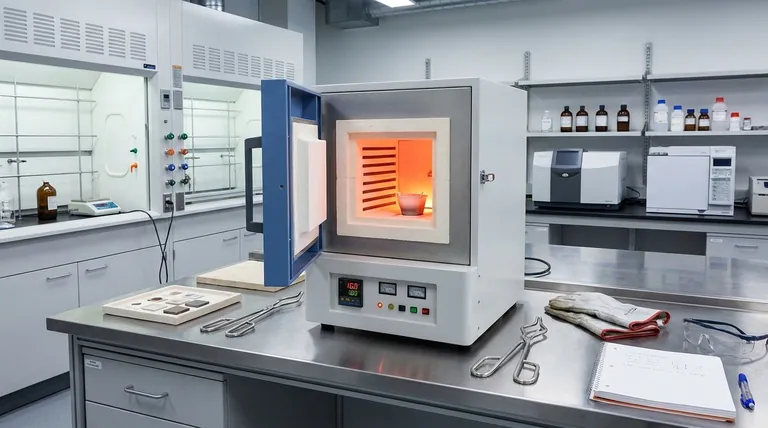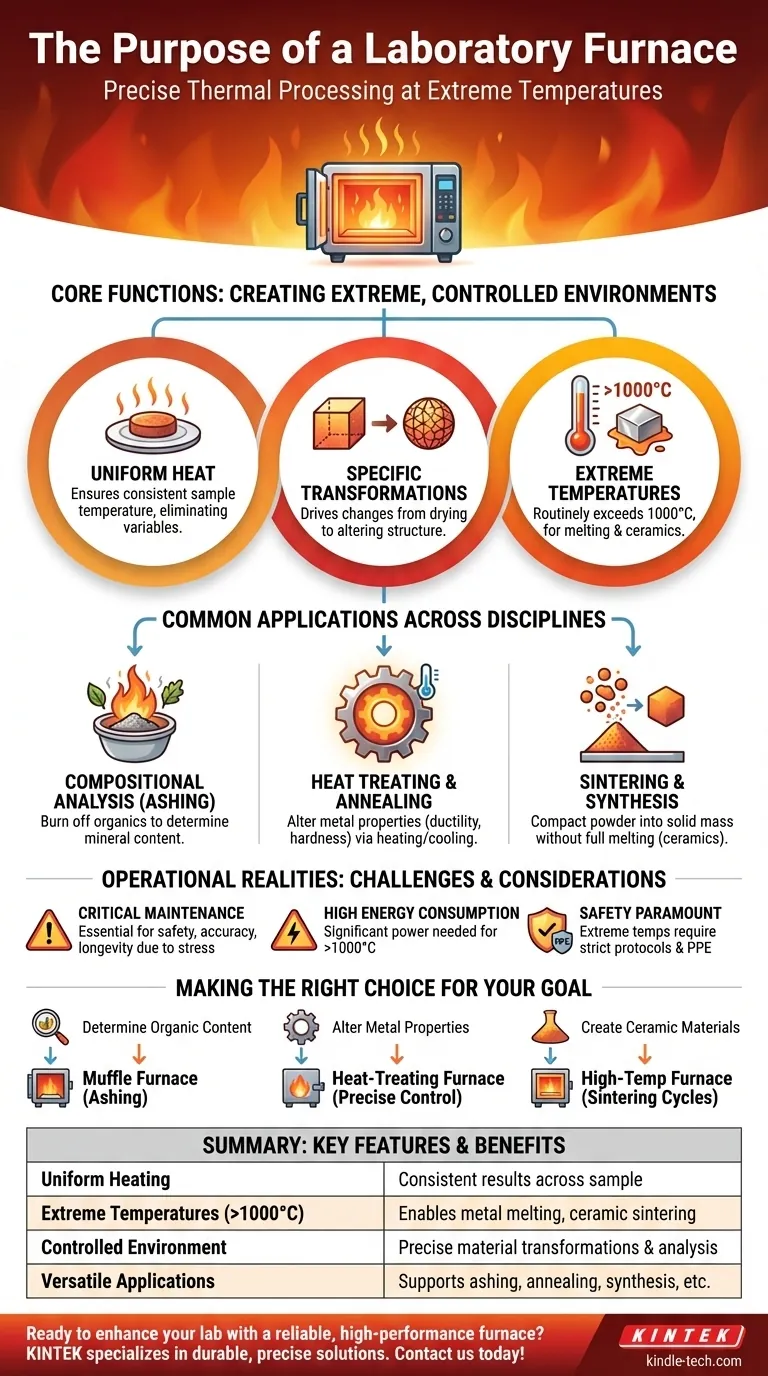In essence, a laboratory furnace is a high-performance oven designed to generate precise and uniform heat at extreme temperatures. Its primary purpose is to enable the thermal processing of materials, facilitating tasks like chemical analysis, melting metals, heat-treating components, or burning away organic compounds from a sample.
A laboratory furnace is not just for heating; it's a critical tool for intentionally altering a material's fundamental physical or chemical state in a highly controlled environment, making it indispensable for advanced research and quality control.

The Core Function: Creating Extreme, Controlled Environments
The value of a laboratory furnace lies in its ability to create conditions that are simply not achievable with standard lab equipment. This capability is built on two key principles.
Achieving Uniform Heat
A critical feature is the delivery of uniform heat. This ensures that the entire sample experiences the same temperature, eliminating variables and guaranteeing that any observed change is a true result of the thermal process, not an artifact of uneven heating.
Enabling Specific Material Transformations
Furnaces provide the high-energy environment necessary to drive specific changes. This can range from simply drying a sample to completely altering its crystalline structure or chemical composition.
Reaching Temperatures Beyond Standard Ovens
While a lab oven might reach 300°C (572°F), a laboratory furnace routinely operates at temperatures exceeding 1000°C (1832°F) and can go much higher. This allows for processes like melting steel, creating ceramics, or performing specific types of chemical analysis.
Common Applications Across Disciplines
The ability to control extreme heat makes furnaces a versatile tool used in numerous scientific and industrial fields.
Compositional Analysis (Ashing)
One of the most common uses is ashing. A sample is heated to a high temperature to burn off all organic matter, leaving only the inorganic ash behind. This allows researchers to accurately determine the mineral content of a substance.
Heat Treating and Annealing
In materials science and metallurgy, furnaces are used for heat treatment. Processes like annealing involve heating a metal to a specific temperature and then cooling it slowly to increase its ductility and reduce hardness, making it less brittle.
Sintering and Synthesis
Furnaces are used to sinter materials, a process where heat is used to compact and form a solid mass of material from powder without melting it to the point of liquefaction. This is fundamental in creating ceramics and certain metal parts.
Understanding the Operational Realities
While powerful, laboratory furnaces are sensitive and expensive pieces of equipment that demand careful consideration. Their high-performance nature introduces specific challenges.
The Critical Role of Maintenance
The combination of high temperatures and prolonged use places immense stress on the furnace's components, especially the heating elements and insulation. Regular maintenance is not optional; it is essential for safety, accuracy, and longevity.
High Energy Consumption
Reaching and maintaining temperatures over 1000°C requires a significant amount of electrical energy. This makes the furnace one of the more expensive pieces of equipment to operate in a lab setting.
Safety as a Paramount Concern
Operating at extreme temperatures introduces inherent risks. Proper training, personal protective equipment (PPE), and adherence to strict safety protocols are mandatory to prevent severe burns and ensure a safe laboratory environment.
Making the Right Choice for Your Goal
The specific application dictates the type of furnace required. Understanding your primary objective is the first step in selecting the right tool.
- If your primary focus is determining organic content: You need a muffle furnace designed for ashing and loss-on-ignition analysis.
- If your primary focus is altering a metal's properties: You need a heat-treating furnace with precise temperature control and possibly an inert atmosphere.
- If your primary focus is creating new ceramic materials: You require a high-temperature furnace capable of controlled heating and cooling cycles for sintering.
Ultimately, a laboratory furnace provides the controlled, high-energy environment necessary to analyze, create, and transform materials at a fundamental level.
Summary Table:
| Key Feature | Benefit |
|---|---|
| Uniform Heating | Ensures consistent results across the entire sample |
| Extreme Temperatures (>1000°C) | Enables processes like metal melting and ceramic sintering |
| Controlled Environment | Allows for precise material transformations and analysis |
| Versatile Applications | Supports ashing, annealing, synthesis, and more |
Ready to enhance your lab's capabilities with a reliable, high-performance furnace?
KINTEK specializes in providing durable, precise laboratory furnaces and equipment tailored to your research and quality control needs. Whether you're performing compositional analysis, heat treating metals, or sintering ceramics, our solutions deliver the uniform, high-temperature environment required for accurate results.
Contact us today to discuss your specific application and find the perfect furnace for your laboratory!
Visual Guide

Related Products
- 1400℃ Muffle Oven Furnace for Laboratory
- 1700℃ Muffle Oven Furnace for Laboratory
- 1700℃ Laboratory Quartz Tube Furnace with Alumina Tube Tubular Furnace
- Laboratory Muffle Oven Furnace Bottom Lifting Muffle Furnace
- 1400℃ Laboratory Quartz Tube Furnace with Alumina Tube Tubular Furnace
People Also Ask
- How is the ash content determined in a muffle furnace? Master the Gravimetric Analysis Method
- How do you control a muffle furnace? Master Precise Temperature Control for Your Lab
- What are the different types of laboratory furnaces? Find the Perfect Fit for Your Application
- What is done by ashing in muffle furnace? A Guide to Precise Inorganic Content Analysis
- What is the difference between a box furnace and a muffle furnace? Choose the Right Lab Furnace for Your Application



















